Forecast for the Provo Area Mountains

Issued by Drew Hardesty on
Wednesday morning, November 28, 2018
Wednesday morning, November 28, 2018
Areas of CONSIDERABLE danger exist on steep mid and upper elevation northwest to easterly facing slopes. The danger is more pockety on west and southeasterly aspects, but the danger is the same. Remember these slides may be triggered at a distance, even from the flats below.
The danger is LOW on south and southwesterly facing slopes where the new snow landed on bare ground.

Low
Moderate
Considerable
High
Extreme
Learn how to read the forecast here









